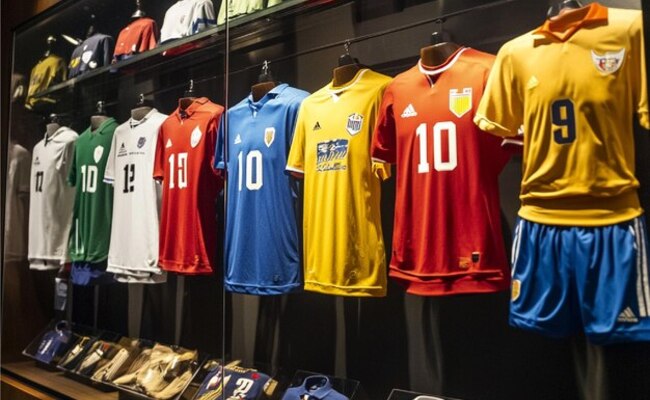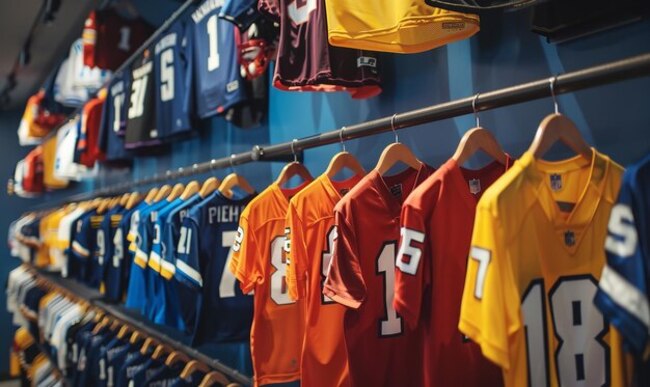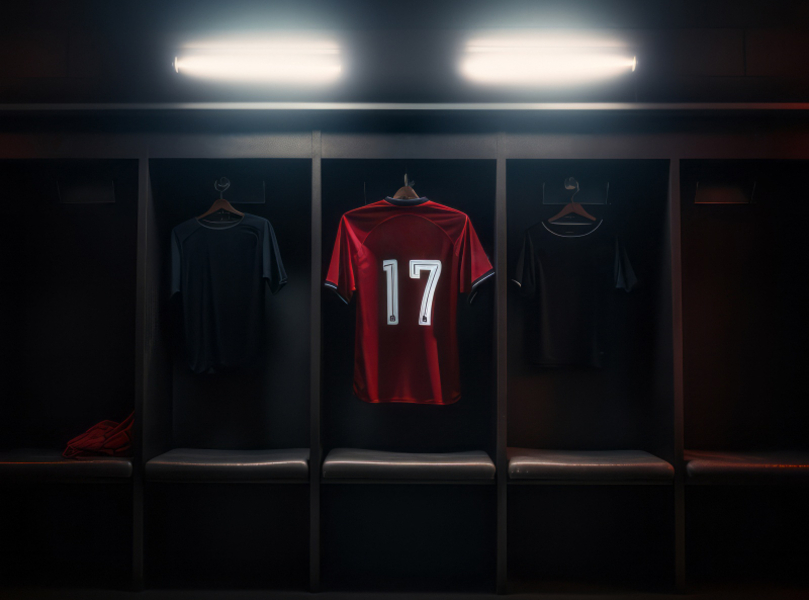Owning a retro football shirt is like holding a piece of football history and a symbol of timeless style. Whether you’re an avid fan of the sport or someone who loves the charm of vintage fashion, an authentic shirt carries a unique story. Yet, figuring out whether a shirt is a genuine original or a modern reproduction can feel like solving a puzzle.
These shirts represent more than just clothing; they hold memories of legendary matches and iconic players. With their standout designs, exceptional detailing, and historic value, they stand apart from today’s mass-produced jerseys. By learning to recognize important details such as materials, badges, and labels, you’ll gain the confidence to identify authentic pieces and add them proudly to your collection

Why Retro Football Shirts Are More Than Just Memorabilia
Retro football shirts are more than just clothing—they’re gateways to football’s golden moments and cultural evolution. From iconic matches to unforgettable players, each shirt tells a unique story that resonates with fans and collectors alike. By exploring their historical significance, unique designs, and value as collectibles, you’ll uncover why these jerseys continue to capture the hearts of football enthusiasts around the world.
The Historical Significance of Retro Football Shirts
Retro football shirts are not just pieces of clothing; they are symbols of football’s rich history. These shirts often represent key moments in the sport’s legacy, whether it’s a championship victory or a player’s iconic performance.
Here are some reasons why retro football shirts hold historical significance:
- Connection to Iconic Moments: They represent memorable matches, wins, and events.
- Tributes to Legendary Players: Many shirts are tied to specific players who left a lasting impact on the game.
- Time-Capsule Designs: The designs, colors, and materials reflect the era they come from, adding to their nostalgic appeal.
These historical ties make retro football shirts more than collectibles—they’re cherished reminders of unforgettable moments in the sport. Whether you’re a fan or a collector, they bring football’s glorious past to life.
Unique Design Elements of Retro Football Shirts
The charm of retro football shirts lies in their distinctive design. Unlike modern jerseys, these shirts feature elements that reflect the style of a particular time in football history.
Some unique design features include:
- Vintage Colors and Patterns: Bold colors and creative patterns that stand out.
- Classic Logos and Badges: Original crests and logos, often embroidered for a premium feel.
- Material Differences: Retro shirts are often made with thicker or softer fabrics compared to modern synthetic materials.
These design details evoke a sense of nostalgia, reminding fans of the iconic matches and players they admire. By embracing these elements, retro shirts become conversation starters and stylish throwbacks.
Why Retro Football Shirts Are a Collector’s Dream
Owning a retro football shirt is about more than just style; it’s about preserving history. These shirts tell stories of a team’s victories and a player’s defining moments.
Collectors value retro shirts because:
- They hold personal or historical significance.
- They’re often rare and hard to find in good condition.
- They showcase unique craftsmanship and design not found in modern jerseys.
Adding a retro football shirt to your collection brings pride and a deeper connection to the sport you love. It’s a way to celebrate football’s legacy while owning a piece of its incredible history.

Unlocking the Secrets of Authentic Retro Football Jerseys
Retro football jerseys are more than just memorabilia—they’re pieces of history that connect us to iconic matches, players, and moments. Identifying an authentic retro jersey requires a keen eye for detail and an appreciation for the craftsmanship of the past. By focusing on key features like stitching, patterns, logos, and materials, you’ll learn to distinguish genuine pieces from modern replicas and build a collection that truly celebrates football’s legacy.
Identifying Retro Stitching and Tags
When searching for an authentic retro football jersey, stitching and tags can be a treasure trove of clues. These details often hold the key to identifying whether your find is genuinely retro. Taking a closer look can reveal the story behind the jersey’s origins.
Here are some points to consider when inspecting stitching and tags:
- Stitching Style: Retro jerseys often feature thicker, more visible stitching, which was common in older manufacturing methods.
- Tag Details: Look for tags with retro-style fonts, old washing instructions, or even the brand logo from the era.
- Age Indicators: Tags can sometimes indicate the time period with unique designs or labels specific to certain decades.
By learning to spot these features, you’ll gain a deeper appreciation for the craftsmanship of the past. Stitching and tags are small details, but they carry big significance when verifying authenticity and adding value to your collection.
Recognizing Retro Colours and Patterns
The colours and patterns of a retro football jersey are its most eye-catching features. These unique designs make retro jerseys stand out from the crowd and tell a story about the era they represent. Paying attention to these visual cues can help you identify a true classic.
Here’s what to look for in colours and patterns:
- Authentic Designs: Retro jerseys often feature bold patterns that reflect the style of their time.
- Color Quality: Older dyes may appear less vibrant or slightly faded, which can be a sign of authenticity.
- Printing Techniques: Retro printing methods can lead to subtle imperfections in patterns or logos.
The charm of faded colours and retro patterns lies in their ability to transport you back to iconic moments in football history. By understanding these elements, you’ll not only spot authentic retro jerseys but also connect with the nostalgia they evoke.
Examining Logos and Emblems for Authenticity
Logos and emblems are the soul of a retro football jersey, representing the identity of the team or event it celebrates. These details are often where you can spot the difference between a genuine retro piece and a reproduction. Let the logo be your guide to authenticity.
Key features of logos and emblems to keep in mind:
- Embroidery: Genuine retro jerseys often have logos that are embroidered rather than printed.
- Signs of Wear: Minor wear or fraying around the emblem can add charm and indicate age.
- Design Differences: Older logos may have slight variations from modern ones, reflecting their historical context.
By carefully examining the logos and emblems, you’ll feel closer to the legacy and pride they represent. These details are not just about aesthetics; they’re part of the story that makes retro football jerseys so meaningful.
Understanding Retro Fabrics and Materials
The fabric of a retro football jersey can tell you so much about its authenticity. Unlike the lightweight, stretchy materials used today, retro jerseys have a texture and feel all their own. Getting familiar with these differences will help you make confident choices.
Here are some material features to look for:
- Heavier Fabric: Retro jerseys often use thicker, more durable materials.
- Unique Textures: The fabric may feel coarser or more rigid compared to modern jerseys.
- Historical Accuracy: Specific materials were popular in different eras, offering clues to the jersey’s age.
The feel of a retro jersey isn’t just about identifying its origin—it’s part of the experience of owning a piece of history. Let the material transport you to a time when football jerseys were crafted with care and durability.
Uncovering the Story Behind Retro Sizing Labels
Retro football jerseys often have unique sizing labels that differ from today’s standardized sizes. These labels provide important clues about the era the jersey was produced in and can help you verify its authenticity. Understanding how sizing worked in the past is key for identifying a genuine retro piece.
Here are some key points about retro sizing labels:
- Size Variations: Sizing used to be less standardized, meaning a “Medium” could vary greatly depending on the era or manufacturer.
- Label Designs: Older jerseys often feature hand-sewn or stitched labels, unlike the printed or heat-applied tags of today.
- Era-Specific Markings: Many labels include information like the manufacturer’s logo or year of production, giving valuable insight into the jersey’s origins.
Sizing labels do more than just indicate fit; they provide a window into the production standards and craftsmanship of a particular time. By recognizing these details, you’ll not only spot an authentic retro jersey but also gain a deeper connection to its historical significance.
Detecting Age Through Wear and Tear
The condition of a retro football jersey can tell you a lot about its authenticity. Genuine retro jerseys often show signs of natural wear and tear that reflect their age and usage over time. Knowing how to distinguish authentic aging from artificial distressing is crucial for making informed decisions.
Signs of natural wear and tear to look for include:
- Fading and Discoloration: Colors may have softened or faded due to decades of use and washing.
- Fraying or Loose Threads: Slight fraying along edges or seams can indicate age rather than damage.
- Worn Emblems and Logos: Embroidered logos might show minor thread pulls or fading, a hallmark of age.
The charm of a retro football jersey lies in its imperfections, each of which tells a story about its journey through time. Learning to appreciate these characteristics will not only help you verify authenticity but also enhance your enjoyment of owning a truly unique piece of football history.

Mastering the Art of Spotting Genuine Retro Football Jerseys
Exploring the world of retro football jerseys can be thrilling, but it’s also full of challenges. To avoid fakes and secure genuine pieces, it’s important to know what to look for and where to focus your efforts. From identifying trusted sellers to spotting red flags, mastering these key steps will give you confidence as you build a collection that celebrates the rich history of football.
Recognizing Common Red Flags When Buying Retro Football Jerseys
Spotting red flags is essential when purchasing retro football jerseys to ensure you’re investing in authentic pieces. Paying attention to these warning signs can save you from scams and disappointment. Let’s break down what to watch out for when shopping for retro gems.
Here are some common red flags to look out for:
- Unrealistic Pricing: If the price seems too good to be true, it likely is. Genuine retro jerseys often reflect their rarity and quality in their cost.
- Vague Seller Information: A lack of transparency or missing details about the seller is a major warning sign.
- Poor Photos and Descriptions: Genuine sellers usually provide high-quality images and detailed descriptions showcasing key details like stitching and tags.
By staying alert to these red flags, you’ll become more confident in spotting genuine sellers and authentic jerseys. Remember, investing a little time to verify the seller and product can save you money and ensure you get the quality you’re looking for.
Using Online Resources to Verify Retro Football Jerseys
In today’s digital age, online tools and communities can be your best allies when verifying retro football jerseys. With access to forums, collector sites, and image databases, you can quickly compare and confirm authenticity. Leveraging these resources will make you a smarter, more informed buyer.
Here’s how online resources can help:
- Collector Forums: Engage with online communities where enthusiasts share images and tips about genuine retro jerseys.
- Reference Images: Compare jerseys you’re considering to verified examples using collector sites or brand archives.
- Authenticity Guides: Read articles or guides that break down key details to look for, like logos, stitching, and tags.
By utilizing these tools, you’ll develop a sharper eye for spotting authentic jerseys. Online communities can also connect you with experts who are willing to share their insights, making the verification process even smoother and more reliable.
Ensuring Trustworthy Sellers When Buying Retro Football Jerseys
Choosing the right seller is one of the most important steps in ensuring you’re purchasing an authentic retro football jersey. Sellers with a proven track record of providing genuine items and excellent customer service can make all the difference. Doing a bit of homework on your seller can save you from disappointment.
Key factors to consider when evaluating a seller:
- Reputation: Look for reviews and ratings that indicate the seller’s reliability.
- Transparency: A trusted seller will provide detailed product information, including the history and specifics of the jersey.
- Return Policies: Legitimate sellers often have fair return policies, a sign they stand behind the authenticity of their products.
By focusing on reputable sellers, you’ll increase your chances of finding genuine jerseys and enjoying a seamless buying experience. Trustworthy sellers also add value by providing you with confidence in your purchase and the knowledge that your jersey is truly authentic.
Checking for Authentic Tags and Labels on Retro Jerseys
Authentic tags and labels are among the most telling signs of a genuine retro football jersey. These small details carry a wealth of information about the jersey’s origin, age, and authenticity. Learning what to look for will make identifying retro jerseys much easier.
What to inspect in tags and labels:
- Manufacturer Details: Authentic jerseys will often include the maker’s name or logo.
- Era-Specific Fonts and Designs: Tags should match the design trends of the era the jersey represents.
- Additional Information: Look for details like washing instructions or unique serial numbers.
Studying these subtle details can give you the confidence to distinguish genuine jerseys from fakes. Tags and labels are not just functional; they’re a historical record of the jersey’s journey and craftsmanship.
Seeking Expert Opinions on Retro Football Jerseys
If you’re unsure about the authenticity of a retro football jersey, turning to experts can provide clarity and confidence. Experienced collectors and industry professionals have a wealth of knowledge that can help you make informed decisions. Their advice can save you from costly mistakes.
Why expert opinions are invaluable:
- Knowledge of Details: Experts can spot subtle signs of authenticity, such as stitching techniques or logo placement.
- Community Insights: Many collectors are happy to share tips and answer questions in forums or local groups.
- Authentication Services: Some professionals offer authentication services for a small fee, providing peace of mind.
By tapping into expert resources, you’ll gain a better understanding of what to look for and avoid in your search for authentic jerseys. It’s a great way to learn from those who’ve spent years mastering the art of retro jersey identification.
Conclusion
Finding an authentic retro football jersey takes attention to detail, but the satisfaction is unmatched. By examining materials, logos, and tags closely, you’ll develop the skills needed to identify the real thing. Researching reliable sellers and being mindful of red flags can help you avoid counterfeits and ensure your collection is filled with genuine treasures.
For football enthusiasts and vintage lovers alike, a genuine retro jersey is more than just clothing—it’s a piece of history. It brings nostalgia into your wardrobe and sparks conversations about legendary matches and players. Futbol Fever Shop is here to help you find your next classic jersey. Explore our collection and bring home a timeless piece of football culture to celebrate your passion for the game.
Frequently Asked Questions
How can I tell if a retro football jersey is an original or a reproduction?
Look closely at details like the stitching, fabric, and labels. Originals often feature thicker stitching, embroidered logos, and unique sizing tags, while reproductions might use modern synthetic materials and standardized tags.
Are there specific years or eras when retro football jerseys are most valuable?
Jerseys from iconic matches or significant historical moments in football, such as World Cups or legendary player debuts, are highly sought after. The rarity and condition of the jersey also play a big role in its value.
What’s the best way to maintain and care for a vintage football jersey?
Hand washing in cold water with a mild detergent is ideal to preserve the fabric and designs. Avoid using a dryer or ironing over logos to prevent damage to the jersey’s delicate elements.
Where can I find authentic retro football jerseys?
Trusted online retailers, collector forums, and vintage sports shops are great starting points. Always research sellers and check for authenticity markers like original tags, unique stitching, and historical details.
Can I wear a retro football jersey regularly, or should it be kept as a collectible?
Retro jerseys can be worn for special occasions, but frequent use may increase wear and tear. If preserving it as a collectible, store it in a cool, dry place away from direct sunlight and humidity to maintain its condition.

